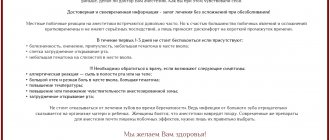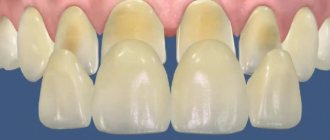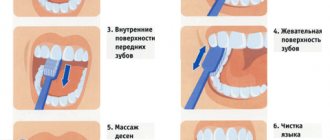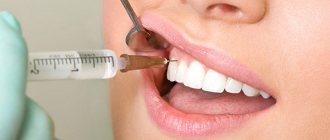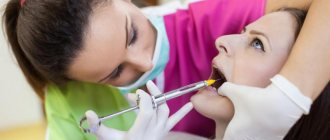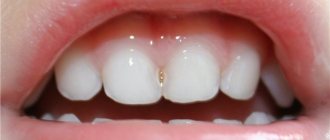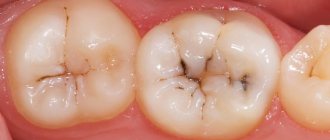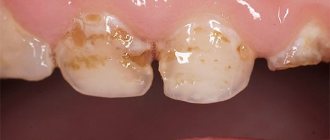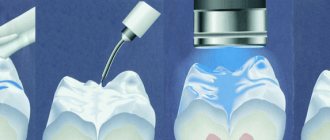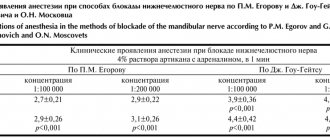Anesthesia according to Egorov
The syringe is placed at the opposite corner of the mouth. An injection is made in the upper part of the pterygomandibular fold, 1.5 cm below and outward from the hook of the pterygoid process of the sphenoid bone. The needle is advanced through the intermuscular space in the direction of the branch of the lower jaw. Having reached the inner surface of the mandibular branch, after performing an aspiration test, 2-5 ml of anesthetic is released, which will concentrate in the loose connective tissue of the pterygomandibular space and diffuse to the inferior alveolar nerve lying there. With this approach, the inferior alveolar nerve is not yet united with the artery and vein, which protects against the development of a hematoma. In addition, it reduces the risk that is observed with anesthesia at the mandibular foramen by other methods. As more precise guidelines, P.M. Egorov (1985) recommends dividing the branch of the lower jaw into 4 quadrants by two intersecting lines: a vertical one drawn through the middle of the notch and the recess in front of the angle of the lower jaw along its lower edge, and a horizontal one connecting the most concave part of the anterior the edges of the lower jaw and the concave part of its posterior edge, i.e. through the center of the mandibular ramus. The needle, moving through the pterygomandibular space, enters the middle section of the posterior upper quadrant of the mandibular ramus. P.M. Egorov recommends performing anesthesia by identifying the necessary landmarks with your fingers. The thumb of the left hand is inserted into the vestibule of the mouth and fixed in the area of the anterior edge of the branch at the coronary notch or at the same point from the outside - from the side of the skin. The nail phalanx of the ring finger of the left hand is fixed along the posterior edge of the ramus of the lower jaw, corresponding to the base of the condylar process. The little finger of the left hand is placed in the depression anterior to the angle of the lower jaw, along its lower edge. The index finger is fixed under the lower edge of the zygomatic arch. The third finger is placed between the I and IV fingers slightly posterior (up to 1 cm) from the midline of the lower jaw branch and in line with the little finger. Thus, the third finger in this position is in the anteroinferior corner of the posterosuperior quadrant of the ramus, above the opening of the lower jaw, i.e. in the projection of the pterygomandibular space. The needle is inserted into the intermuscular triangle, located below the lower edge of the lateral pterygoid muscle, lateral to the medial pterygoid muscle and medial to the temporal muscle. The needle is advanced to the area of the lower jaw branch, fixed with the third finger of the left hand. With mandibular anesthesia according to Egorov, the lower alveolar and lingual nerves are “switched off”, and less often the buccal nerve.
Did you like the article? Share with friends
0
Similar articles
Next articles
- Mandibular anesthesia according to Lagardie
- Mental anesthesia
- Case history: exacerbation of chronic granulomatous periodontitis
- Trunk anesthesia
- Case history: Chronic localized catarrhal gingivitis
Previous articles
- Anesthesia according to Go-Gates
- Thorusal anesthesia
- Mandibular anesthesia
- Incisal anesthesia
- Palatal anesthesia
Add a comment
Dental anesthesia
In addition, today patients place increasing demands on the comfort of dental treatment. And providing adequate pain relief is a necessary and integral part of quality dental treatment.
Methods of pain relief in dentistry can be non-drug and medicinal.
Pain relief without medications is psychotherapy (hypnosis), electrical anesthesia (electroanalgesia), audio analgesia and others. To carry out these methods of pain relief, additional training of doctors and the availability of special equipment are required, and the resulting effect is not always significant for the clinic, therefore, these methods are not widely used in practice.
Medicinal methods of pain relief include: local anesthesia (injection or application anesthesia) and general anesthesia (anesthesia, which is used very limitedly and strictly according to indications).
The most widely used are medicinal methods, among which the most common in the clinic is local anesthesia, which includes injection and application methods.
Application anesthesia involves applying an anesthetic gel or spray to the gums (without an injection); after some time, after a tingling sensation, a superficial analgesic effect occurs. Injection anesthesia involves injecting a drug into the tissue surrounding the tooth.
When performing anesthesia, the doctor must solve the following problems:
Firstly, local anesthesia should be as effective as possible and completely eliminate pain sensitivity in the area of intervention.
Secondly, it is necessary to minimize the systemic effect on the body of substances that are part of the local anesthetic drug (local anesthetic, vasoconstrictor, preservatives and stabilizers).
From all of the above it follows: the doctor must have at his disposal a varied selection of anesthetics, be able to navigate the properties of each of them, competently apply the anesthetic taking into account the individual characteristics of each specific patient, monitor the resulting effect and make timely adjustments if necessary.
Source: https://www.estedent74.ru/uslugi/sovremennoe-lechenie-zubov/obezbolivanie.html

